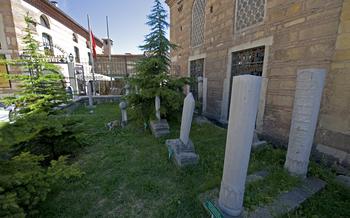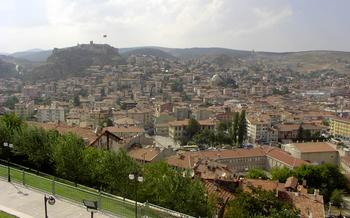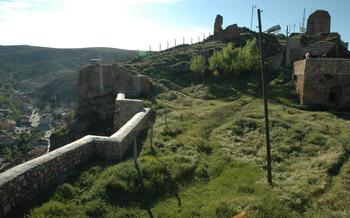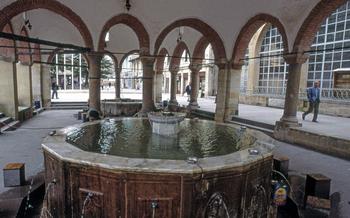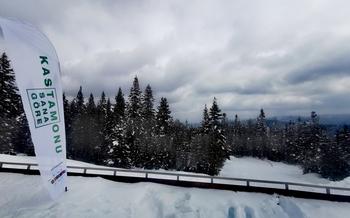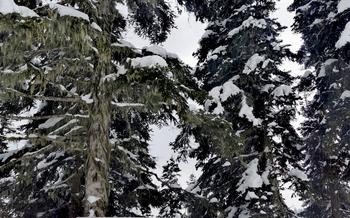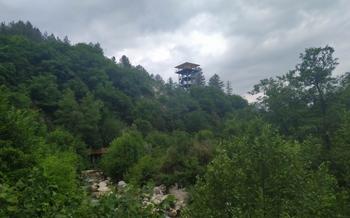
Kastamonu University Ethnography Museum
- Kastamonu University Ethnography Museum: A Cultural Haven
- Location and Accessibility:
- Curated Collection: A Glimpse into Turkish Traditions
- Exhibitions and Galleries
- Historical Context
- Hands-On Experience
- Architecture and Design
- Educational Programs
- Research and Conservation
- Events and Workshops: A Vibrant Cultural Scene
- Admission and Visitor Information:
- Recommended Tour Duration
- Nearby Attractions:
- Insider Tip: Unveiling the Secrets of the Kastamonu University Ethnography Museum
Kastamonu University Ethnography Museum: A Cultural Haven
Nestled in the heart of Kastamonu, Turkey, the Kastamonu University Ethnography Museum stands as a testament to the region's rich cultural heritage. Established in 1999, the museum houses a diverse collection of artifacts that narrate the captivating story of Kastamonu's past and traditions. With its educational and cultural significance, the museum serves as a beacon of knowledge, preserving and showcasing the unique identity of this vibrant region.
The Kastamonu University Ethnography Museum is a treasure trove of cultural artifacts, meticulously curated to offer visitors an immersive journey into the depths of Turkish traditions. From intricate textiles and ornate jewelry to traditional tools and household items, each exhibit tells a unique tale of the region's craftsmanship, lifestyle, and beliefs. The museum is not just a repository of artifacts; it is a living testament to the enduring spirit of Kastamonu's people, a symbol of their heritage that continues to inspire and captivate generations.
Location and Accessibility:
The Kastamonu University Ethnography Museum is conveniently located in the heart of Kastamonu city, at the following address: Kastamonu Üniversitesi Kampüsü, Merkez Kampüs, 37050 Kastamonu.
Reaching the museum is a breeze, with multiple transportation options available. Visitors can easily hop on a local bus or taxi from the city center to arrive at the museum's doorstep. The museum's proximity to other major attractions in Kastamonu makes it an ideal stop on a cultural exploration tour of the city.
For those arriving by car, ample parking space is available on the museum premises, ensuring a hassle-free visit. Visitors can park their vehicles and immerse themselves in the cultural treasures that await them within the museum's walls.
Curated Collection: A Glimpse into Turkish Traditions
The Kastamonu University Ethnography Museum boasts an extensive and diverse collection of artifacts that vividly showcase the rich cultural heritage of Turkey. Among the highlights of the collection are intricate carpets and textiles, each narrating a tale of craftsmanship and regional designs. Visitors can marvel at the vibrant hues and intricate patterns that adorn these handwoven masterpieces, reflecting the creativity and skill of Turkish artisans.
The museum also houses a remarkable array of traditional costumes, providing a glimpse into the diverse ethnic groups and regional dress styles that have shaped Turkey's cultural fabric. From elaborate wedding attire to everyday garments, these costumes offer a fascinating insight into the history and customs of the Turkish people.
Unique pieces from the Kastamonu region hold a special place in the museum's collection. These artifacts, ranging from finely crafted pottery and ceramics to intricately carved woodwork, embody the unique artistic traditions of the region. Visitors can explore these distinctive creations and gain an understanding of the local craftsmanship that has flourished in Kastamonu for generations.
The museum's collection extends beyond mere objects; it serves as a medium for storytelling, narrating the rich history and vibrant traditions of Turkey. Each artifact carries a story, a glimpse into the lives, customs, and beliefs of the Turkish people. Through these carefully curated exhibits, visitors embark on a journey of cultural discovery, gaining a deeper appreciation for the diverse heritage that makes Turkey a captivating destination.
Exhibitions and Galleries
The Kastamonu University Ethnography Museum boasts a diverse collection of permanent and temporary exhibitions that showcase the rich cultural heritage of Turkey and the Kastamonu region.
Permanent Exhibits:
The museum's permanent exhibits offer a comprehensive overview of Turkish traditions and customs, with artifacts ranging from traditional clothing and textiles to household items and agricultural tools. These exhibits provide a glimpse into the daily lives of people from various regions of Turkey, highlighting the diversity and richness of Turkish culture.
Temporary Exhibitions:
In addition to the permanent exhibits, the museum also hosts temporary exhibitions that explore specific themes or topics related to Turkish ethnography. These exhibitions often feature unique artifacts and objects that are not typically on display, making them a must-see for visitors interested in delving deeper into Turkish culture.
Guided Tours and Audio Guides:
For a more immersive experience, visitors can opt for guided tours led by knowledgeable museum staff. These tours provide in-depth insights into the exhibits and their significance, allowing visitors to gain a deeper understanding of Turkish culture and history. Audio guides are also available for self-guided tours, offering visitors the flexibility to explore the museum at their own pace.
Interactive Displays for Visitors:
The Kastamonu University Ethnography Museum incorporates interactive displays and multimedia presentations to enhance the visitor experience. These interactive elements engage visitors of all ages, providing a fun and educational way to learn about Turkish ethnography.
Historical Context
Kastamonu, situated in the Black Sea region of Turkey, boasts a rich and storied history that dates back to antiquity. In the 11th century, it became part of the Seljuk Empire, playing a pivotal role as a frontier town. Later, it fell under the rule of the Ottoman Empire, serving as a significant administrative center. This diverse historical heritage is reflected in the artifacts and exhibits at the Kastamonu University Ethnography Museum.
The museum houses a wealth of artifacts that showcase the region's unique cultural heritage. Visitors can explore traditional costumes, jewelry, pottery, and tools that provide glimpses into the daily lives of past generations. Of particular interest are the intricate carpets and kilims woven by local artisans, renowned for their vibrant colors and intricate patterns.
The museum not only preserves Kastamonu's cultural heritage but also serves as a bridge to its past. Through its exhibits, visitors can trace the development of the region's diverse communities, their interactions with neighboring cultures, and the role they played in shaping Turkey's rich history.
Hands-On Experience
The Kastamonu University Ethnography Museum offers visitors a unique opportunity to engage with exhibits through hands-on workshops and activities. These interactive experiences allow visitors to delve deeper into the cultural history of the region and gain a firsthand understanding of traditional practices.
Workshops are conducted by skilled artisans and experts who demonstrate traditional techniques and guide participants in creating their own crafts. From intricate embroidery to pottery making, these workshops provide a hands-on learning experience that brings the museum's collection to life.
Visitors can also participate in demonstrations of traditional crafts, such as weaving, woodworking, and metalworking. These demonstrations offer a glimpse into the skills and craftsmanship that have been passed down through generations in Kastamonu.
By engaging with the exhibits in a hands-on manner, visitors can gain a deeper appreciation for the region's cultural heritage and leave with a unique souvenir to remember their visit.
Architecture and Design
The Kastamonu University Ethnography Museum stands out for its unique architectural features, which seamlessly blend modern and traditional elements. The building's contemporary design incorporates traditional Turkish motifs and patterns, showcasing the region's rich cultural heritage. The exterior facade features intricate carvings and embellishments that reflect the artistry and craftsmanship of the region. The interior spaces are designed to create a welcoming and engaging environment for visitors. Natural light floods the galleries through strategically placed windows, illuminating the artifacts and creating a warm and inviting atmosphere. The museum's architecture is not just aesthetically pleasing but also functional, ensuring that visitors have a comfortable and enjoyable experience as they explore the exhibits.
Educational Programs
The Kastamonu University Ethnography Museum is not only a treasure trove of artifacts but also an active center for education and cultural preservation. The museum offers a range of educational programs tailored to different age groups and interests.
Collaborations with schools and universities bring students to the museum for guided tours, workshops, and hands-on learning experiences. These programs aim to instill a deep appreciation for Kastamonu's cultural heritage and encourage the next generation to become stewards of their traditions.
Outreach initiatives extend the museum's educational impact beyond its walls. The museum collaborates with community organizations to conduct cultural workshops, storytelling sessions, and traditional craft demonstrations. These initiatives foster a sense of cultural identity and promote heritage awareness among the wider community, especially among the youth.
Through these educational programs, the museum plays a vital role in preserving and transmitting Kastamonu's rich cultural heritage to future generations. By engaging with the museum's exhibits and activities, visitors gain a deeper understanding of the region's history, traditions, and the significance of cultural preservation.
Research and Conservation
The Kastamonu University Ethnography Museum is not just a place to showcase artifacts; it also plays a crucial role in research and documentation. The museum houses a team of dedicated researchers who conduct in-depth studies on the artifacts and the cultural practices they represent. This research contributes to the preservation and understanding of Turkey's rich cultural heritage.
The museum's conservation efforts are equally noteworthy. Artifacts are carefully preserved using state-of-the-art techniques to ensure their longevity. Digitization initiatives further protect the artifacts by creating digital records that can be accessed by researchers and the public. Collaborative projects with other institutions allow the museum to share its expertise and resources, contributing to a broader understanding of cultural heritage.
Events and Workshops: A Vibrant Cultural Scene
The Kastamonu University Ethnography Museum is not merely a repository of artifacts; it is a dynamic hub of cultural activities that brings Kastamonu's heritage to life. Throughout the year, the museum organizes a variety of events and workshops that invite visitors to engage with the region's traditions and customs in a hands-on manner. From traditional music performances and storytelling sessions to hands-on craft workshops, these events offer a unique opportunity to immerse oneself in the vibrant cultural tapestry of Kastamonu.
The museum's traditional music performances showcase the rich musical heritage of the region, featuring talented local musicians who serenade visitors with enchanting melodies and rhythms. Storytelling sessions transport visitors to another era, as skilled narrators weave tales of Kastamonu's history, folklore, and legends.
Hands-on craft workshops provide a chance for visitors to learn traditional crafts and techniques from local artisans. Whether it's weaving, pottery, or woodworking, these workshops offer a unique opportunity to create a tangible memento of one's visit to the museum.
The museum also hosts festivals and celebrations that highlight Kastamonu's unique cultural traditions. These events showcase local cuisine, traditional dances, and handicrafts, creating a lively and festive atmosphere that captivates visitors.
By participating in these events and workshops, visitors can gain a deeper understanding of Kastamonu's rich cultural heritage and forge a personal connection with the region's traditions.
Admission and Visitor Information:
The Kastamonu University Ethnography Museum offers a budget-friendly experience with affordable admission fees. Locals and students can take advantage of discounted rates, while group tours may be eligible for special concessions.
Guided tours are available upon reservation, providing visitors with in-depth insights into the exhibits and their historical significance. These tours are conducted by knowledgeable guides who bring the museum's artifacts to life.
For a comprehensive and enriching visit, allocate at least two hours to fully explore the museum's galleries and exhibits. This will allow you to delve into the rich cultural heritage of Kastamonu and appreciate the intricate details of the artifacts on display.
The museum provides essential facilities for visitors' convenience, including well-maintained restrooms and a gift shop. The gift shop offers an array of souvenirs, replicas, and local handicrafts, making it an ideal place to find unique mementos of your Kastamonu experience.
Recommended Tour Duration
To fully immerse yourself in the cultural treasures of the Kastamonu University Ethnography Museum, we recommend dedicating at least two hours for your visit. This will allow you to leisurely explore the permanent exhibits, delve into the temporary exhibitions, and engage with the interactive displays. Take your time to read the descriptions, appreciate the intricate details of the artifacts, and soak in the stories they tell. For a more in-depth experience, consider joining a guided tour, which typically lasts around 90 minutes and provides valuable insights into the history and significance of the exhibits. Remember to pace yourself and take breaks to truly absorb the cultural richness that surrounds you.
Nearby Attractions:
Enrich your journey by exploring the captivating attractions surrounding the Kastamonu University Ethnography Museum. Embark on a historical quest as you delve into the Kastamonu Castle, a formidable fortress that once guarded the city. Discover the intricate beauty of the Nasrullah Mosque, with its elegant architecture and serene atmosphere. Explore the vibrant Kastamonu Bazaar, a bustling marketplace where you can immerse yourself in the local culture and savor the flavors of traditional Turkish cuisine. Plan a comprehensive itinerary that seamlessly integrates a visit to the Ethnography Museum with these nearby treasures, creating a holistic and unforgettable travel experience in Kastamonu.
Insider Tip: Unveiling the Secrets of the Kastamonu University Ethnography Museum
For an immersive experience, plan your visit to coincide with one of the museum's special events or exhibitions. These events often showcase unique aspects of Kastamonu's culture, such as traditional music performances, storytelling sessions, or hands-on craft workshops. Immerse yourself in the vibrant atmosphere and engage with the local community to gain a deeper understanding of the region's rich heritage. Keep an eye out for the museum's social media channels or website for upcoming events and exhibitions to make the most of your visit.

